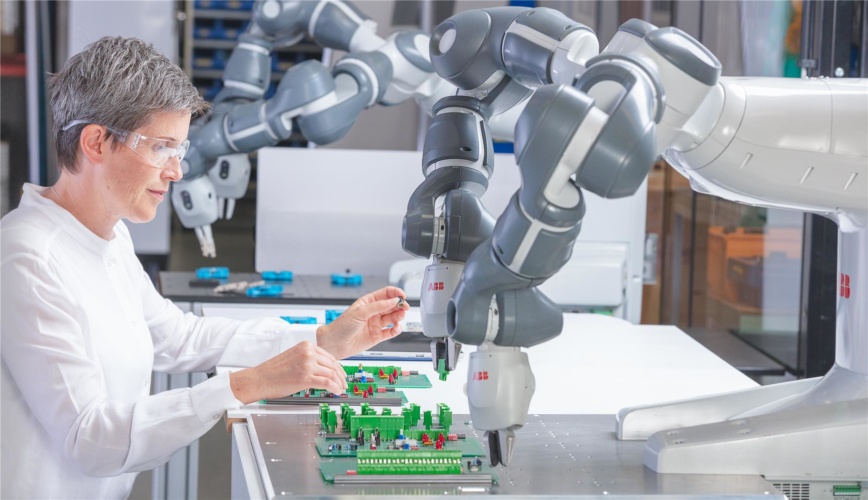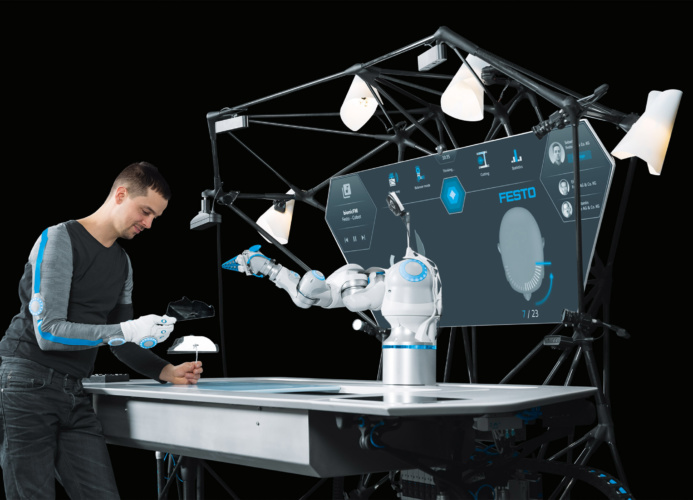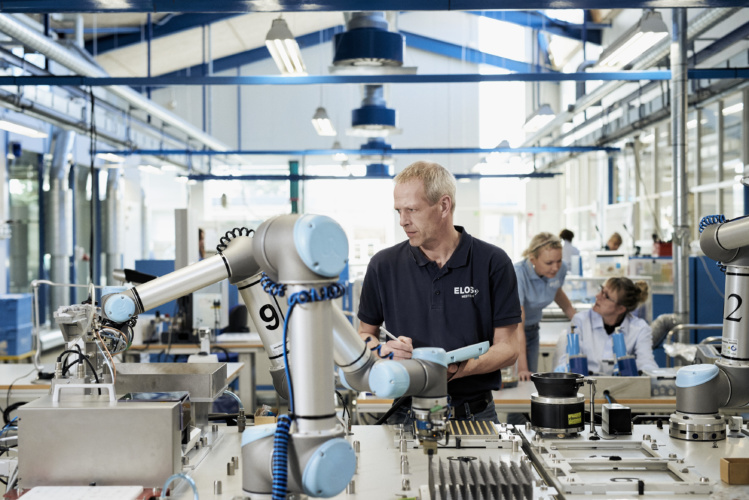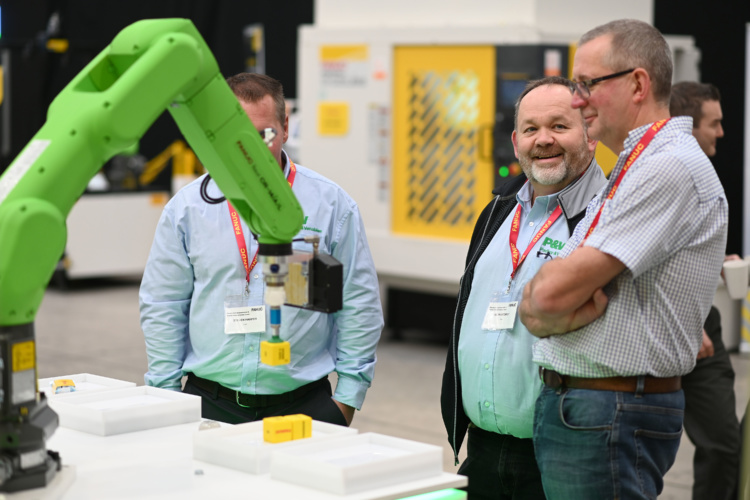
Collaborative robots are becoming an increasingly key technology for manufacturers, enabling them to cost-effectively embrace the benefits of automation and exploit the advantages of a closer working relationship between humans and robots. The Engineer asked a panel of experts for their views on the current state of the art in this rapidly growing field.
Meet the experts
- Mark Gray - UK Sales Manager, Universal Robots
- Nigel Platt - LBL Manager UK and Ireland, ABB
- Steve Sands - Festo GB head of product management
- Oliver Selby - Technical Sales Support Engineer at FANUC UK
What are key trends in cobots at the moment?
SS: The fast growth in interest and sales of cobots is in many cases due to their ease of use. Outside of academia, most applications we see are not truly collaborative but are co-existent, with a shared or overlapping work space for human operators and robots. The control features, performance limitations, design and surface treatments enable these robots to be safely installed within this shared space and this is driving the fast uptake and acceptance. Falling prices are a key commercial trend: as volumes increase, there is more pressure to drive down costs, and this is reflected in average prices.
Technical developments are very much around topics such as vision and sensor systems integration. This means making it easier to bridge the gap between the very simple programming that cobots have brought us – teach-in positions, drag and drop, icon-based instructions, etc. – and the add-on functions such as inputs from vision systems for component selection and orientation. Essentially, it’s all about adding flexibility and utility to these devices, increasing the scope of their capability.
Cobots are an integral part of the overall digitalisation / Industry 4.0 evolution. Their increasing use of open standards enables them to connect and communicate within the umbrella environment, taking and sharing data.

MG: Customer demand for flexible automation is driving huge advancements in the market for “plug and produce” end-of-arm tools. Universal Robots’ cobots were always intended from day one to make automation accessible to companies of all sizes but the huge range of “off the shelf” grippers and other accessories that have become available is now taking this even further. Our ecosystem of out-of-the-box end-effectors, is continually growing and now numbers over 200.
NP: Simple to install, cobots are also easier to program and operate. Reducing implementation costs, collaborative robots make it possible for SMEs to adopt cobots to replace dull, dangerous or dirty jobs previously done by people. Employees can then be upskilled as robot operators or placed in more creative roles.
What’s the key product for you currently and how would you describe its benefits and advantages?
OS: With a view to tackling global skills shortages and the need to increase production flexibility, FANUC has launched its first ever lightweight collaborative robot, the CRX-10iA. Weighing just 39kg, it can be easily installed across a broad range of applications. Crucially, underneath the CRX-10iA’s ergonomic frame lies a fully-functioning industrial robot, with a payload capacity of 10kg and a vision system that enables autonomous loading and unloading of containers or shelving systems.
MG: Our main product is the e-Series cobot which we offer in four different models. An evolution of our original cobots, the e-Series retains our founding principles of creating user-friendly robots that are affordable, flexible and easy to programme and redeploy. However, further developments in the hardware and software have enabled us to offer further advantages to customers with this new line. For example, an in-built force/torque sensor enhances precision and sensitivity. Each joint is easily replaceable and it comes with 17 built-in safety functions for the benefit of its operators.
NP: SafeMove2 is a suite of software which allows operators greater freedom to collaborate with robots in a limited space. It can be used across the entire range of industrial ABB robots, making every robot a cobot. It uses configurable electronic motion detection and prevention measures which restrict a robot’s speed, motion and position when a person comes near.
Another key product is our YuMi cobot, which can work hand-in-hand with humans without further protective measures. It can perform the motions required in small parts assembly within a very small space while maintaining a human-like reach. This minimises the spec needed and makes it possible to install YuMi into the workstations currently used only by humans.
How are your products helping customers meet the challenges that they are facing?
OS: FANUC’s diverse portfolio of industrial robots opens a pathway for anyone looking to automate, from small, incremental steps, through to significant levels of investment.
A perfect example of this is Cranfield University’s Aerospace Integration Research Centre (AIRC), which has turned to FANUC’s collaborative robots to boost productivity and cut cost through greater human interaction. The CR-35iA is used to install large components on aircraft, such as wings, which are heavy and awkward to manually move about.
MG: It’s becoming more difficult for SME manufacturers to recruit and retain skilled labour so finding sustainable ways to increase the output per worker is proving a regular challenge. For example, there’s a very forward-thinking garden furniture manufacturer in Sleaford, Lincolnshire that is using our cobot to sand down wooden parts. The company has increased its output per worker and the staff are happier as the cobots have freed them up from one of the more monotonous and unpleasant aspects of their role. Another common challenge we’re helping with is worker safety. For example, Carlsberg has almost eliminated accidents at its Fredericia plant in Denmark since integrating cobots into its operations.

NP: Payments software provider Abrantix uses ABB YuMi robots to automate their testing. The Abrantix software instructs the YuMi robot to test common ATM operations such as inserting cards, typing in PIN codes and withdrawing and inserting money. Human errors such as inserting money bound with a paper clip can also be tested. Equally Panda Confectionery in Finland uses YuMi to pack its range of pick and mix confectionery into boxes. The results are a boost in productivity and competitiveness for the Finland based plant.
How do you see cobotics evolving in the coming years?
OS: One area in which cobots are likely to make significant advancements is with their external sensors. Current sensing technology limits the speed at which cobots can work because it cannot assess quickly enough if a person is getting too close. As vision systems catch up, cobots will be able to work more quickly, and increase overall efficiency and productivity, without compromising on safety.

Another exciting possibility is the potential improvements they offer to factory accessibility. Manufacturing facilities are invariably standardised. However, collaborative robots present the opportunity to adapt to the unique requirements of the operator. Taking component assembly as an example, this could be through the cobot holding components in the most ergonomic position, at a height to suit the employee. For anyone with limited mobility, such as those in a wheelchair, this opens up a host of possibilities.
MG: I think the biggest evolution won’t be in the technology itself but in its adoption, especially by SMEs. The UK has traditionally been slow to adopt robots. However, things are rapidly changing as the twin challenges of productivity and labour shortages continue to drive companies to seriously consider automation.
To accelerate this adoption, Universal Robots recently announced a cobot leasing programme that reduces the up-front costs of automating still further. I think this will prove significant as it removes one of the final barriers for companies that want to make the leap to automation. Cobots typically pay back their costs in less than a year meaning once companies have taken that first step it quickly becomes cost-effective to deploy more.
SS: Increasing deployment flexibility is a key part of cobotics evolution. Combining cobots with AGVs creates a highly adaptable, mobile assistive resource. Powerful, yet simple user interfaces will enable rapid re-deployment according to demand. This will be supported by apps libraries, making it easier to describe the task required rather than having to program the individual movements. Inevitably this will all be assisted by AI algorithms for performance optimisation, collision and fault avoidance and preventative maintenance.




Glasgow trial explores AR cues for autonomous road safety
They've ploughed into a few vulnerable road users in the past. Making that less likely will make it spectacularly easy to stop the traffic for...